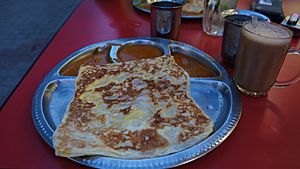Mamak stall facts for kids

Mamak stalls are popular food places found in Southeast Asia, especially in Malaysia and Singapore. They serve a special kind of Indian Muslim food that is unique to this region. These stalls can be indoors or open-air, offering a casual spot to eat.
What are Mamak Stalls?
Mamak stalls are run by people whose families came from South India. These families are part of the Malaysian Indian or Singaporean Indian community. The word 'Mamak' comes from the Tamil word for "maternal uncle." In Malaysia and Singapore, children sometimes use it to respectfully address adults like shopkeepers. While the word itself is kind, it can sometimes be used in a negative way. Because of this, people usually only use 'Mamak' when talking about these specific food stalls.
Mamak stalls are similar to Hindu stalls, but there's a key difference in what they serve. Mamak stalls are run by Muslims, so they do not serve pork but do serve beef. Hindu stalls serve neither beef nor pork. You can also find similar food stalls run by local Malay people.
How Mamak Stalls Look

Mamak stalls are known for their affordable food and relaxed vibe. This makes them a great place for casual dining. Newer Mamak stalls often look more like modern cafes. They are usually well-lit and have stainless steel tables.
Some stalls even have large flat-screen televisions or projectors. This lets customers watch their favorite shows or live sports games while they eat. Many Mamak stalls also offer free Wi-Fi. Even with these new features, many modern stalls still keep their open-air feel. They set up tables on patios, walkways, or even on the street. This helps them keep the traditional outdoor dining experience.
Delicious Mamak Food
Mamak stalls offer a wide variety of tasty dishes and drinks. A classic order is different kinds of roti canai with a frothy teh tarik. You can also find coffee, Milo, Horlicks, and soft drinks.
Most Mamak stalls also serve various rice dishes. These include nasi lemak and nasi goreng (fried rice). You can also find noodle dishes like mee goreng (fried noodles). Some stalls even offer satay or Western-style meals.
Here are some popular dishes and drinks you might find at a Mamak stall:
- Roti canai (Malaysia and Brunei)
- Roti prata (Singapore)
- Teh tarik (Malaysia, Indonesia, and Singapore)
- Half-boiled eggs
- Murtabak
- Thosai
- Chapati
- Nasi kandar
- Biryani
- Nasi lemak
- Nasi goreng
- Maggi goreng (fried Maggi noodles)
- Mee goreng (fried egg noodles)
- Mie goreng (Indonesia)
- Mee rebus (egg noodles dish)
- Bihun goreng
- Kwetiau goreng (Indonesia)
- Char kway teow
- Indomie (Indonesia)
- Pasembur (Penang, Kedah, Northern Perak)
- Mamak Rojak
- Indian Rojak (Singapore)
- Ayam Goreng (fried chicken)
- Maggi sup
- Bihun sup
- Sup Kambing (goat soup)
- Sup Ayam (chicken soup)
- Sup Tulang
- Roti Tissue
- Roti Bakar
- Kaya toast (Singapore)
- Roti Bawang
- Roti Bom
- Roti Cheese
- Roti Planta
- Roti Pisang
- Roti Telur
- Roti Sardin
- Roti Jantan
- Roti Milo
- Naan with tandoori chicken
- Puri or Poori
- Papadum
- Ais Kosong
- Limau Ais Kosong
- Nescafe
- Neslo (Nescafe with Milo)
- Horlicks
- Barli
- Limau Ais
- Kopi
- Milo Ais
- Milo Kosong
- Milo Panas
- Milo 'O'
- Sirap
- Sirap Limau
- Sirap Bandung
- Teh Ais (Iced tea)
- Teh Halia
- Teh 'O' Ais
- Teh 'O' Ais Limau
- Teh 'O' Panas
- Teh 'O' Kosong
Malay Tom Yam Stalls
To offer even more choices, some Mamak restaurants have added a special section called a Malay tom yam stall. These stalls are often run by Malay cooks from North East Peninsular Malaysia or Southern Thailand. They bring a different flavor to the restaurant, offering dishes like:
- Tom yam
- Nasi paprik
- Nasi goreng Kampung (village fried rice)
- Nasi goreng Cina (Chinese fried rice)
- Nasi goreng USA (fried rice with prawn, squid, and chicken)
- Nasi masak merah (red-cooked rice)
- Nasi pattaya (Pattaya style fried rice from Thailand)
- Telur bistik
- Sayur campur (mixed vegetables)
- Ikan pedas (spicy fish)
- Nasi lala (clam rice)
Tom yam stalls first became popular in Peninsular Malaysia in the late 1970s and early 1980s. The food is mostly Thai-inspired, with sweet, hot, and sour flavors. These dishes are cooked fresh when you order, making tom yam stalls a bit like a fast-food option but with Thai-style cooking.
You can find tom yam stalls not just in Mamak restaurants, but also by the street or in special areas like car parks at night. They are very popular places to eat.



